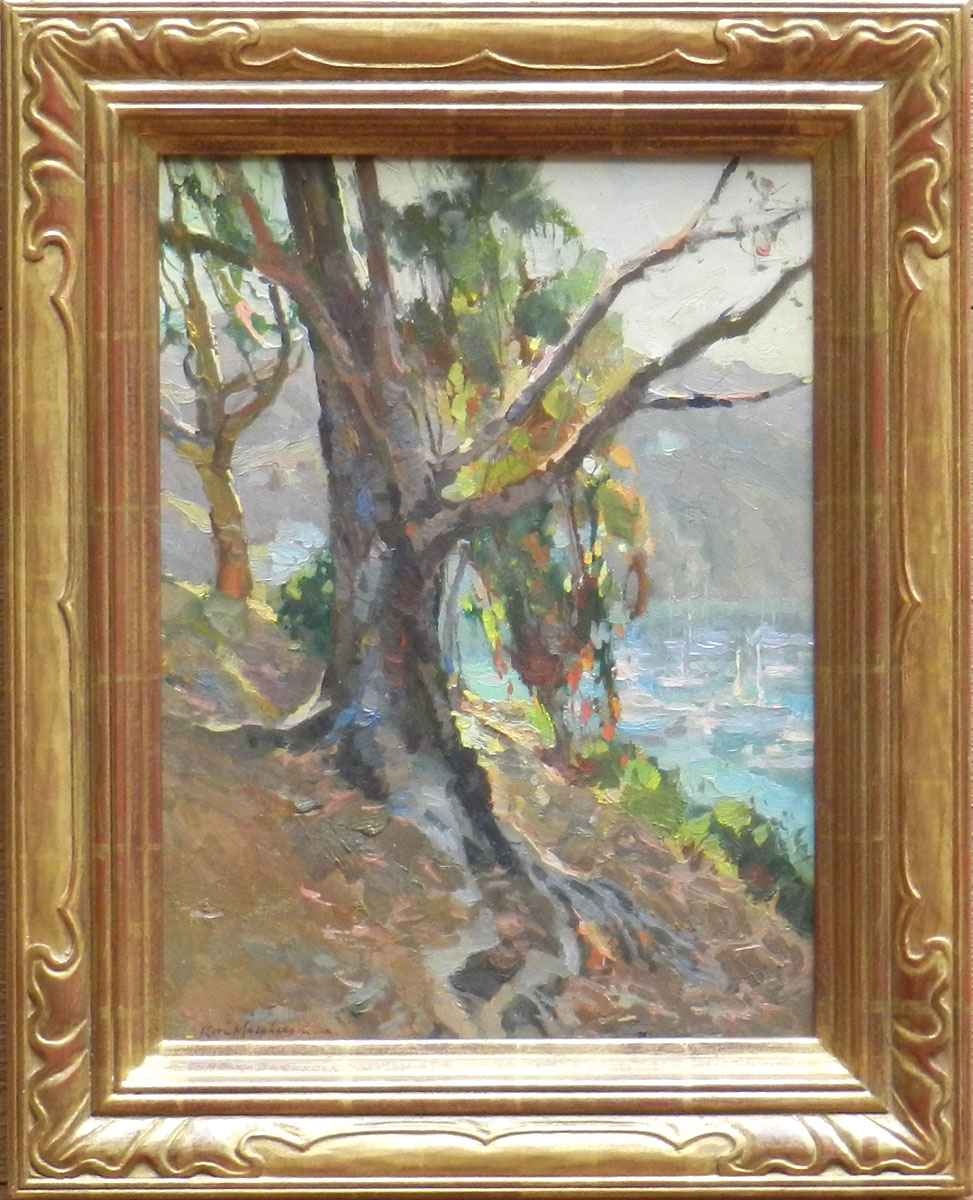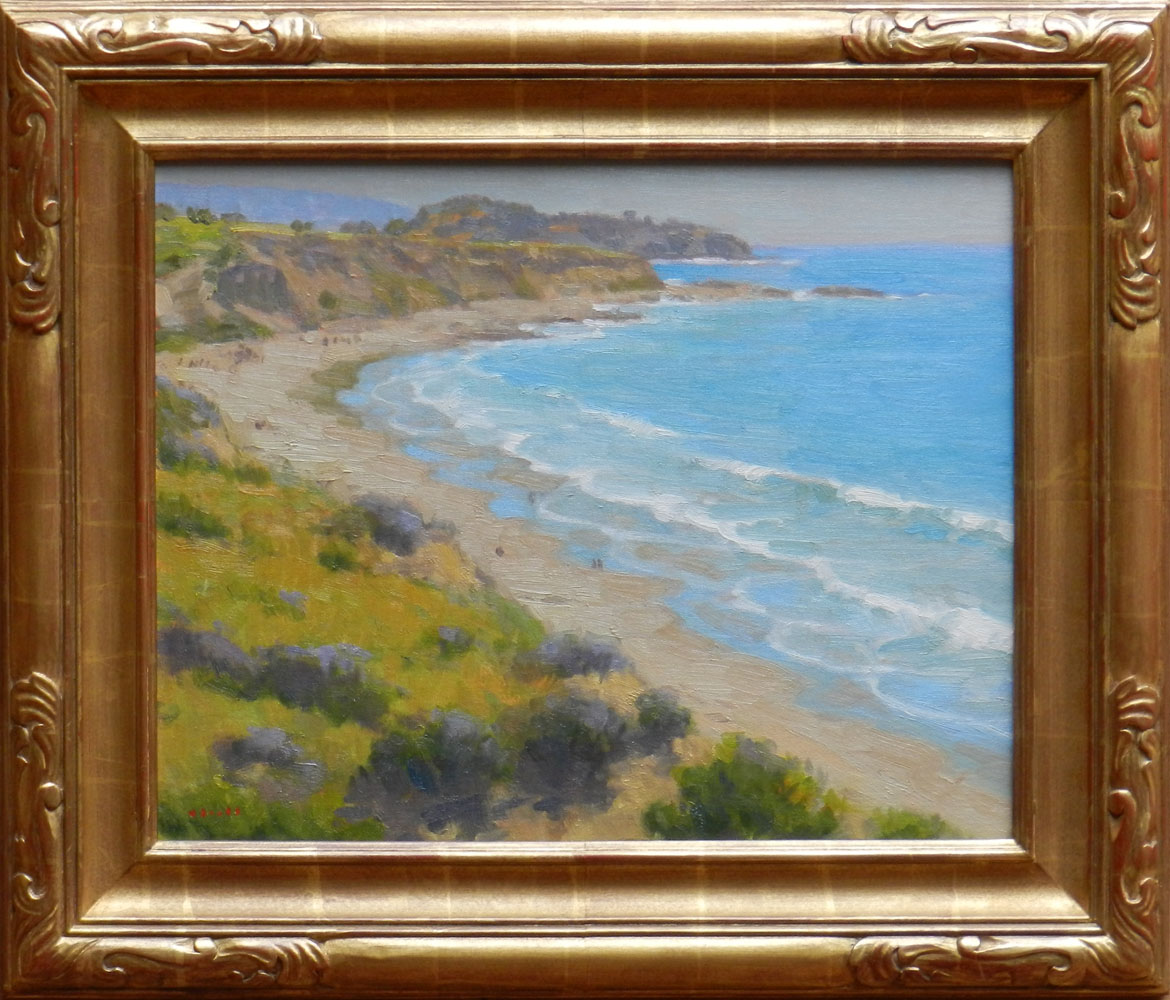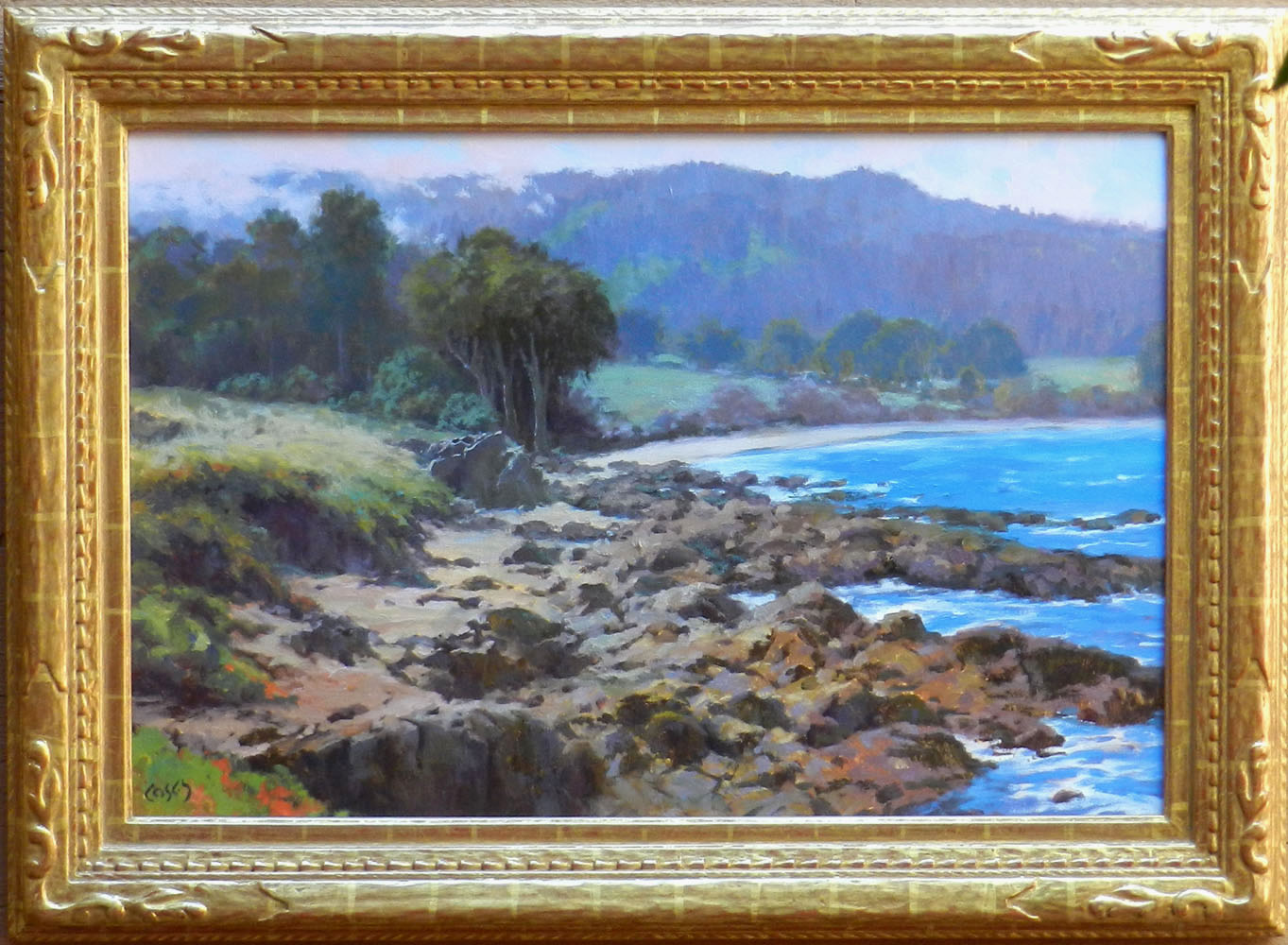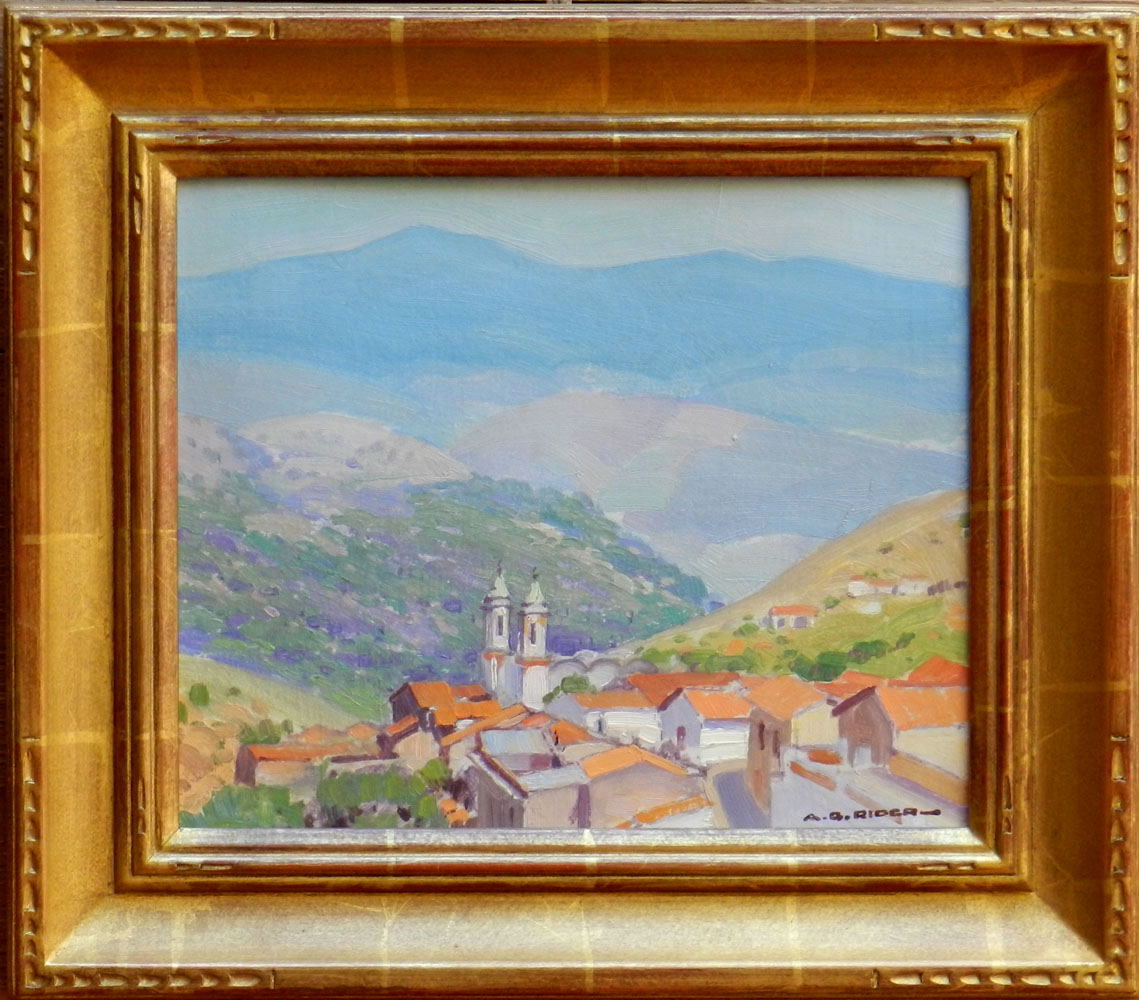|

Click on the Image to see more
paintings
Kevin Macpherson
(current) |
|
 |
|
Promise
Tree
16 x 12 inches |
KEVIN MACPHERSON brings treasured
memories from our beloved Catalina Island.
It truly is an island of romance. Perhaps
the charm of the island and the artistic
movement of this magnificent tree compelled
Macpherson to immortalize the scene on
canvas. The Promise Tree glistens in
the sunlight with a multitude of colors
dancing off the canvas. In the
distance, is a peaceful harbor full of
sailboats.
|
|
|
|
|
 |
|
Crystal
Cove Afternoon
16 x
20
inches |
|
GREGORY HULL
is a master painter of all subjects, but it is
his outdoor impressionist work that is his passion.
Hull is a disciplined artist whose work appears to be
effortless. Here California's gold coast is
defined with perfect color harmonies and spontaneous brush
work. Hull recently painted the California coast.
Please click on the image for a preview of his new
paintings on our web site. |
|
|
|
|
 |
|
A Quiet
Day
24 x 36 inches |
|
JOHN COSBY delivers a unique
perspective of the lush coast of central California. The
artist invites the viewer to walk along the rocky coast. A
Quiet Day implies that there are few people or distractions to
interfere with the peacefulness of this day. It is indeed
a welcome break from the demands of daily life and
the business of the modern world. |
Arthur Grover Rider
(1886-1975) |
|
 |
|
Rooftop Vista
10 x 12 inches |
|
ARTHUR GROVER
RIDER was born in Chicago, Illinois on March
21, 1886. Rider received his early training at the Academy
of Fine Arts in Chicago. In his student years, he painted for
the Chicago Lyric Opera and later traveled to Europe. While
living in London, he painted for the London Opera at Covent
Garden.
He further
studied at Académies de la Grande-Chaumiére and Colarossi in
Paris, and exhibited there at the George Petite Galleries.
For nine summers, he painted in Spain where
he met Joaquin Sorolla who greatly influenced his work. They
painted together on the Valencian Beach. In 1924, he moved to Los Angeles, and
during the 1930s maintained a studio-home in nearby Laguna
Beach. For over thirty years he was one of the leading
scenic artists with MGM and Fox Studios. Making
several trips to Taxco, Mexico he painted the charming
cathedrals and buildings with the red tile roofs.
|

San Diego Museum of Art GAUGUIN TO WARHOL
October 4 through January 27, 2015
The Irvine Museum
SCENIC VIEW AHEAD:
THE WESTWAYS COVER ART PROGRAM 1928-1981 October 11, 2014 through January 15, 2015.
Pasadena Museum of
California Art
AN OPENING OF THE FIELD: JESS, ROBERT, DUNCAN AND THEIR
CIRCLE
through Jan 11,
2015 ARMIN HANSEN: THE ARTFUL VOYAGE
January 25 through May
31, 2015
Laguna
Art Museum
CALIFORNIA RURAL, 1930s
and 1940s through
February 15, 2014 SELECTIONS FROM THE PERMANENT
COLLECTION
including
works by the Laguna Beach painters Frank Cuprien, Anna
Hills, Edgar Payne, and William Wendt.
Bowers Museum
CALIFORNIA THE GOLDEN YEARS permanent collection
UPCOMING: ADAMS, WESTON AND CURTIS: PHOTOGRAPHERS OF THE
AMERICAN WEST Spring 2015
Art Walk
FIRST THURSDAYS ART WALK - December 4, 6 pm - 9 pm
Presenting Laguna College of Art and Design Mentoring
Program Emmalyn Tringali painting "Tidepools"
|
|
George Demont Otis
(1879-1962)
|
|
When
Autumn Comes
circa
1928
34
x 40 inches |
Exhibited:
State Exposition Building Art Exhibit, Exposition
Park, Los Angeles, CA December 1, 1928 through
December 31, 1928
Original price $500.00 on exhibition label
When Autumn
Comes is truly a masterpiece During the
1920s Otis lived in Los Angeles and his studio was
in Burbank, California. Arthur Millier, art critic
for the Los Angeles Times, enthusiastically
praised the artist saying, "...here is a man who has
the essential thing in a landscape painter's
equipment - a strong lyric impulse...".
Fred Hogue, editor of the Los Angeles Times Art page,
wrote: "Otis is a distinctive colorist. His
canvases recall those of no other artist. He
possesses that originality of conception and
composition that is the surest mark of genius..."
Born in Memphis,
Tennessee on September 21, 1879. After three seasons as a
pitcher of Memphis and Nashville clubs, Otis
abandoned a promising baseball career to pursue art.
He first studied art at age 14 at the Art Institute
of Chicago followed by work at the Pennsylvania
Academy of Fine Art, Cooper Union,
National Academy of Design, Artist Student League,
Brooklyn Academy and with Robert Henri, William M.
Chase and John F. Carlson. While maintaining a
studio in Chicago, he traveled extensively, often in
the company of Thomas Moran. Early in century he
lived in Colorado, Taos and Santa Fe, New Mexico.
In 1919, he
moved to Los Angeles where he executed work for the movie studios
and made frequent painting trips to the Indian
reservations of New Mexico and Arizona. Moving to
San Francisco in 1930, he established a studio in
the former Arthur Putnam home and in 1934 built a
home-studio in the small town of Kentfield in Marin
County. He taught hundreds of students during his
lifetime. However, in 1939, he abandoned teaching to
devote full time to painting.
Otis received
many awards including first prize at the California
State Fair for a painting of the Laguna Beach
Woman's Club, and he exhibited widely at the
Metropolitan Museum, New York; Los Angeles Museum of
Art;, Corcoran Gallery in Washington D.C.; Legion of
Honor and the De Young Museum in San Francisco.
Through his
success in Southern California he was acquainted
with many of the early movie stars. Buster
Keaton became a personal friend.
Eventually he became restless and travelled throughout the United States.
An Impressionist,
today he is nationally recognized as a painter of
mountain landscapes, sycamore and eucalyptus trees
and missions. A leader in conservation, he is known
as the artistic father of Pt. Reyes National
Seashore and the Golden Gate National Recreation
area. His works are held at the Art Institute of
Chicago, the Hackely Gallery of Fine Art, Muskegon,
Michigan, the Smithsonian Institute and the White House
in,
Washington D.C.
|
|
|
|
|
|
|

John Bond Francisco
(1863-1931) |
|
Grand
Canyon
circa 1906
Two canvases side by side 16 x
20 inches |
Grand
Canyon was presented in an exhibition titled "Pack-in Painters of the American West"
by the University of Southern California Art Galleries
November 22 - December 23, 1976.
Like looking through a window, these two canvases were
painted together side by side, on location, in order to encompass the
majesty
of the Grand Canyon. A large canvas could not be packed
into the canyon by mule, so the artist decided to use two
canvases to create a panoramic scene. Each canvas
is a complete painting, so they could easily be framed as
two separate paintings.
Francisco
was one of the earliest artists to paint the west. This work was likely painted in 1906 when he
first visited northern Arizona as a guest of the Santa Fe Railroad.
One of his glowing Grand Canyon views was used as a
travel advertisement.
John Bond
Francisco was born in
Cincinnati, Ohio in 1863. He studied art and music at
Ohio State University and went to Europe, painting
with Fechner in Berlin and Nauen in Munich. In Paris,
he studied at the Julian and Colarossi Academies, and
his teachers were William Adolphe Bouguereau, Tony
Robert-Fleury, and Gustave Courtois. He also painted in
Switzerland, Germany, and France and took violin
lessons in Berlin and Paris.
Francisco
was one of the earliest artists to arrive in Los Angeles
where he spent the rest of his life. From 1900 through
the twenties, John Bond Francisco was a major cultural
figure in Los Angeles. He performed as a violinist,
painter, teacher and entertained in his Albany Street
studio. He was a serious young student of both
violin and painting in his home state of Ohio and for
several years in Europe. When he arrived in Los
Angeles in 1887 at the age of twenty-four, he continued
to divide his time between art and music.
In 1897, he contributed to the formation of the Los Angeles
Symphony Orchestra and became its first concertmaster.
He taught students of violin and organized frequent
recitals and chamber music performances. During this
time he continued to paint, working mainly in his
studio. His first exhibition in Los Angeles in 1892 was
primarily figural studies reminiscent of his
Julian Academy days.
He opened his academy of art in 1899. It was
then that he
began to experience the lure of California’s
countryside. He would hitch up a team and drive out for
a day’s painting, often accompanied by students or
colleagues. Elmer Wachtel, who had come to him as a
student, became a frequent painting companion. They
often travelled to the San Bernardino mountain range,
where they hunted, fished
and painted.
|
|
Click on the
images to see more paintings
|
|


